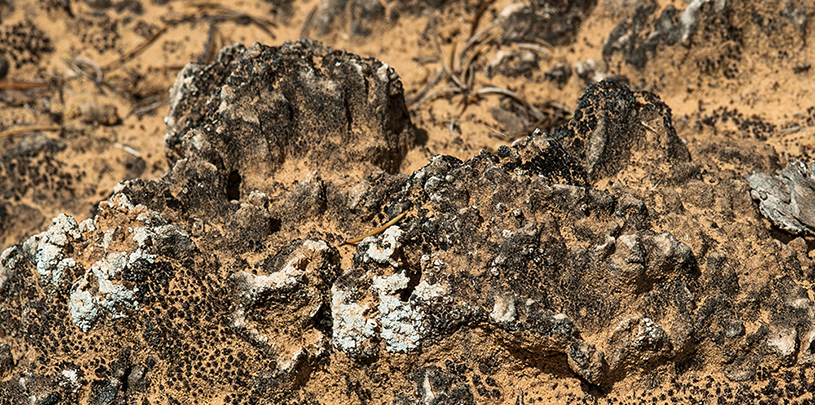
 by Collin Smith, Utah Forests Associate
by Collin Smith, Utah Forests Associate
Most folks associate the term “old-growth” with the towering redwoods of Northern California or the primordial Douglas fir forests of the Pacific Northwest. They remember the battles lost and won while trying to protect trees, whose lives extend beyond a human lifespan or generation, from clearcutting.
Yet our Colorado Plateau deserts have their own living components that stretch centuries into the past as well as the future. Piñon and juniper trees, when left undisturbed, can be hundreds of years old. But often there’s an even more ancient ecosystem lying just underfoot.
Biological soil crust (“biocrust”) is a critical component of healthy desert ecosystems. Cyanobacteria, algae, lichens and mosses make up a community of organisms that provides the foundation for stable desert landscapes. On the Colorado Plateau, healthy biocrusts give the soil a dark, pinnacled appearance, punctuated by brightly colored lichens and fuzzy bulbs of moss. These communities, like old-growth forests, are incredibly well-adapted to their sites and can exist relatively unaltered for centuries.
The organisms in biocrust lie dormant under the glare of the desert sun but spring to life during brief bursts of desert rain, growing, photosynthesizing and pulling carbon and nitrogen from the atmosphere into the soil. Even when inactive, biocrusts hold the soil together, preventing erosion and creating a barrier that reduces exotic grass establishment. Biocrusts even provide habitat for hundreds of species of small arthropods that are the base of the desert food chain.
Like a forest, biocrusts go through successional patterns. A forest might start with a few species of small shrubs and annual plants and, over time, shift towards trees, growing more complex as it matures. The same is true of biocrusts. The pioneers of a biocrust community are fibrous cyanobacteria that wind their way though desert soil, secreting a sticky glue that binds the small particles together into a cohesive crust. From that critical foundation, pigmented cyanobacteria (“dark cyanobacteria”) can colonize.
The pigments these organisms produce act as sunscreen, protecting the crust from ultraviolet radiation. Once this protective and stable community has established, late-successional species like mosses and lichens can move in. They provide the greatest nutrient fixation and soil protection and can help water infiltrate the soil.
But this process takes a long time. Rudimentary crusts, composed of threadlike cyanobacteria (“light cyanobacteria”) can form quickly (0-10 years) depending on soil and rainfall. Lichens and mosses, however, develop on the order of decades.

[Cyanobacteria creating a crust]
Unfortunately, biocrusts, hardy to impacts of sun, wind and rain, can be destroyed in an instant by the impact of a foot, tire – or a cow’s hoof (you may have seen “Don’t bust the crust!” signs in national parks in the Southwest). Physical disturbances like these are as deadly to biocrusts as the clear-cutter’s saw is to an old-growth forest.
In establishing the Grand Staircase-Escalante National Monument in 1996, the Clinton Administration specifically noted, “Fragile cryptobiotic [biological soil] crusts… play a critical role throughout the monument…” Now, the Bureau of Land Management (BLM) is developing a plan to manage livestock, which graze over 96 percent of the 1.8-million acre monument.
To inform that process, the Grand Canyon Trust assessed the condition of biocrust throughout the monument in 2014 and 2015. Volunteers and employee devoted thousands of hours to surveying 176 transects throughout the monument and compiling the data. We compared our results to a similar study conducted by the BLM in 2000-2003, as well as to predictions of biocrust cover on the monument developed by a researcher at Northern Arizona University.
While the 2000-2003 study and the predictive model only address dark cyanobacteria, moss and lichen cover, the Trust’s survey paid close attention to the presence (or absence) of light cyanobacteria, those earliest-stage biocrusts. Including light cyanobacteria has rarely been attempted in a large-scale biocrust survey.
We found that although the transects (straight survey lines) were placed only in areas predicted to have abundant biocrust, no mid- or late-successional biocrusts were intercepted at over a quarter of the sites. At 27 sites, not even light cyanobacterial crusts were observed. Most sites (76%) had less than half their predicted potential.
The BLM claims to value biocrust, and yet in its 2015 Analysis of Management Situation (which sets out issues to be dealt with in its upcoming environmental impact statement for the monument’s first grazing plan), the BLM notes:
Soil crusts may take decades to recover from disturbance… they are not good short-term indicators of the appropriateness of current management actions.
Not true. Absence of even light-cyanobacteria dominated biocrusts at sites where late-successional crusts are expected indicates a current, adverse impact on the area. The BLM has allowed its old-growth biocrusts to be destroyed and now claims that biocrusts are meaningless to current management decisions.
The BLM needs to protect and monitor biocrusts, including early stages of biocrusts. The Trust has submitted a Sustainable Grazing Alternative to the grazing plan EIS process. Our alternative specifically calls for biocrust monitoring and the establishment of large ungrazed areas where biocrusts can recover. Later in 2016, we will be seeking your support for biocrusts and the Sustainable Grazing Alternative in the 2016 Draft EIS for the monument grazing plan.
Our lives are far too short to see recovery of the monument’s old-growth biocrusts, but that is all the more reason to begin that process today.
As 2024 draws to a close, we look back at five maps we created this year that give us hope for 2025.
Read MoreThe new Grand Canyon national monument allows traditional uses like hunting and ranching to continue.
Read MoreYou have the opportunity to comment on how you think some of the most beautiful landscapes in Utah should be managed for the next generation to come.
Read More